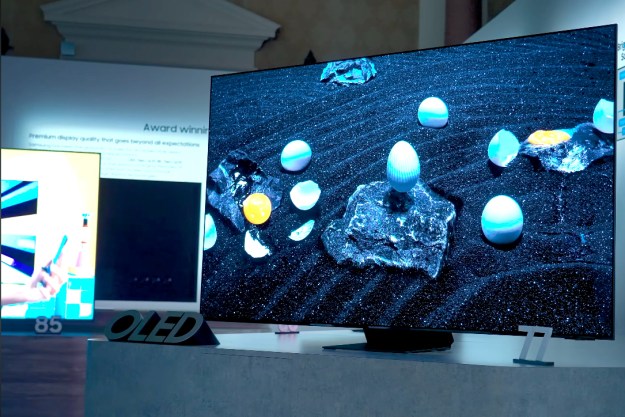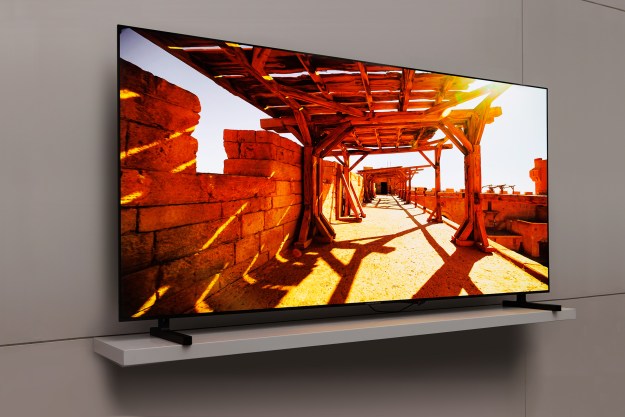
Instead, Samsung is placing its bets on quantum dot display technology as the wave of the future, even as rival LG goes all-in on OLED.
Earlier this year, it was reported that Samsung was merely “hitting the pause button” on OLED televisions. That could technically still be true, but over the weekend, Kim Hyun-seok, the man that heads up Samsung’s TV division, told reporters in Seoul that the company’s strategy with OLED is unchanged, and will remain unchanged throughout next year. In other words: Don’t expect to see any OLED TVs from Samsung at the 2015 Consumer Electronics Show.
Meanwhile, we do expect to see LG show up at CES with a fresh new batch of OLED televisions, with some models likely bringing prices down another significant step. (The company already made a big step in this direction this year with the $3,500 55EC9300 model we reviewed earlier.) LG’s unique approach to OLED technology uses a white sub-pixel in addition to red, green, and blue pixels, which it claims produces better quality than competing techniques.
Samsung will not stand to be one-upped by its arch rival, however. According to a CNET report, the company is fighting back by pouring R&D money into quantum dot televisions, which like OLEDs are a self-emitting technology (they can generate their own light).
Quantum dots are a difficult technology to understand, but their potential benefits are easier to wrap your head around. Think of quantum dots as ultra-tiny particles that will make their own light if electricity is applied to them, or if light is shone on them. That color is directly related to their size, and their color production is extremely stable.
Presently, quantum dots are used to change the color of LEDs into other colors, eliminating the need for a color filter in an LCD panel and producing more accurate, well-saturated colors, along with purer whites. Unfortunately, they still rely on LED backlights, which means displays using the technology must still be carefully engineered to offer other critical picture quality elements, such as deep black levels and uniformly bright screens.
Quantum dots were used in the Amazon Kindle Fire HDX tablet, and were folded into 2013 Sony televisions using its proprietary Triluminous display tech. The Kindle Fire HDX took some heat for having a display with excessive backlight bleed at the edges. The severity of the bleeding was exacerbated due to the fact that the light was blue — the intended effect of the quantum dots.
OLED TVs are hailed for being the ultimate in television technology because they don’t rely on LED backlighting or LCD panels at all. Each pixel produces its own light, so screen uniformity is perfect. And when OLED shows black, it’s jet black. Off-axis performance is also extremely good. To put a finer point on it: OLED doesn’t suffer from any of the limitations LCD panels present, and they don’t require complex workarounds (band-aids, really) to cover up their inadequacies.
LG is also researching the use of Quantum Dots in its televisions, so it is possible that we may see a quantum-dot shootout at CES 2015. LG certainly has all it needs to get into the game — the company has chemical and optical film businesses that would make entering this new market easy. But it’s clear that LG thinks OLED is where TV technology should go in the future, even with quantum dots on its radar. As the only manufacturer offering OLED TVs in any real quantity right now, perhaps LG knows something the rest of us don’t. Or perhaps Samsung’s dots are a diversion tactic, or possibly a way to extend the life of the nearly ubiquitous LCD panel.
While quantum dots may look more like a band-aid technology than a huge breakthrough for displays right now, some analysts think the technology is poised to sell. According to DisplaySearch, forecasting suggests that “quantum dot penetration in LCD TVs will be less than 1 percent in 2015, but will approach 10 percent in 2020, meaning 2 million and over 26 million sets, respectively.”
Editors' Recommendations
- Samsung unveils pricing and preorder details for its 2024 OLED TVs
- Samsung sale knocks up to $1,000 off its best OLED 4K TV
- Samsung’s new QD-OLED panels get Pantone’s stamp of approval for color accuracy
- Samsung confirms its 2023 QD-OLED TVs start at just $1,900, are available now
- Samsung S95C OLED hands-on review: it’s time to get excited




